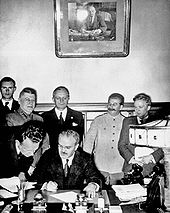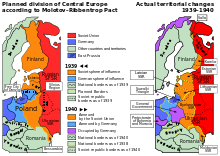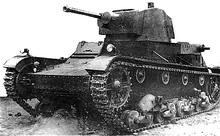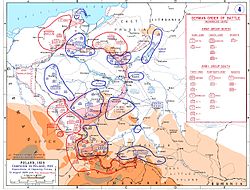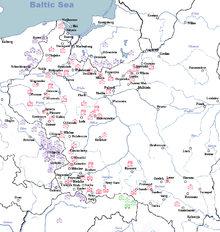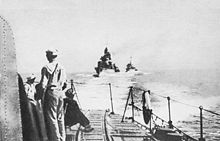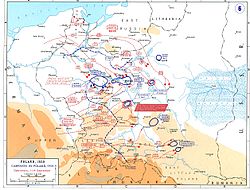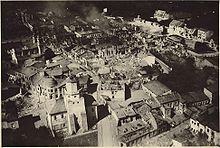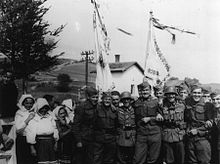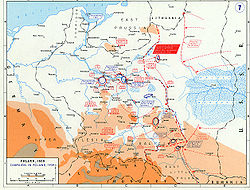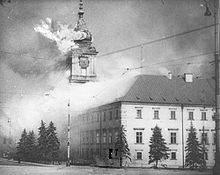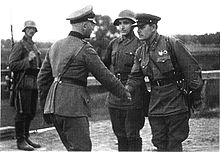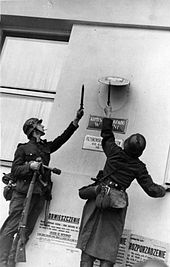
Invasion of Poland
Did you know...
SOS Children, which runs nearly 200 sos schools in the developing world, organised this selection. SOS Child sponsorship is cool!
|
||||||||||||||||||||||||||||||||
|
||||||||||||||||||||||||||||||||
The Invasion of Poland, also known as the September Campaign or 1939 Defensive War ( Polish: Kampania wrześniowa or Wojna obronna 1939 roku) in Poland and the Poland Campaign (German: Polenfeldzug) or Fall Weiss (Case White) in Germany, was an invasion of Poland by Germany, the Soviet Union, and a small Slovak contingent that marked the beginning of World War II in Europe. The German invasion began on 1 September 1939, one week after the signing of the Molotov–Ribbentrop Pact, while the Soviet invasion commenced on 17 September 1939 following the Molotov- Tōgō agreement which terminated the Nomonhan incident on 16 September 1939. The campaign ended on 6 October 1939 with Germany and the Soviet Union dividing and annexing the whole of Poland.
The morning after the Gleiwitz incident, German forces invaded Poland from the north, south, and west. As the Germans advanced, Polish forces withdrew from their forward bases of operation close to the Polish–German border to more established lines of defence to the east. After the mid-September Polish defeat in the Battle of the Bzura, the Germans gained an undisputed advantage. Polish forces then withdrew to the southeast where they prepared for a long defence of the Romanian Bridgehead and awaited expected support and relief from France and the United Kingdom. The two countries had pacts with Poland and had declared war on Germany on 3 September, though in the end their aid to Poland in the September campaign was very limited.
The Soviet Red Army's invasion of Eastern Poland on 17 September, in accordance with a secret protocol of the Molotov–Ribbentrop Pact, rendered the Polish plan of defence obsolete. Facing a second front, the Polish government concluded the defence of the Romanian Bridgehead was no longer feasible and ordered an emergency evacuation of all troops to neutral Romania. On 6 October, following the Polish defeat at the Battle of Kock, German and Soviet forces gained full control over Poland. The success of the invasion marked the end of the Second Polish Republic, though Poland never formally surrendered.
On 8 October, after an initial period of military administration, Germany directly annexed western Poland and the former Free City of Danzig and placed the remaining block of territory under the administration of the newly established General Government. The Soviet Union incorporated its newly acquired areas into its constituent Belarusian and Ukrainian republics, and immediately started a campaign of sovietization. In the aftermath of the invasion, a collective of underground resistance organizations formed the Polish Underground State within the territory of the former Polish state. Many of the military exiles that managed to escape Poland subsequently joined the Polish Armed Forces in the West, an armed force loyal to the Polish government in exile.
Prelude to the campaign
In 1933, the National-Socialist German Workers' Party, under its leader Adolf Hitler, came to power in Germany. Germany sought to gain back her lost territory in Europe, taken by the Treaty of Versailles and also to be eventually surrounded by a ring of allied states, satellite or puppet states. As part of this long term policy, Hitler at first pursued a policy of rapprochement with Poland, trying to improve German–Polish relations, culminating in the German–Polish Non-Aggression Pact of 1934. Earlier, Hitler's foreign policy worked to weaken ties between Poland and France, and attempted to manoeuvre Poland into the Anti-Comintern Pact, forming a cooperative front against the Soviet Union. Poland would be granted territory of its own, to its northeast, but the concessions the Poles were expected to make meant that their homeland would become largely dependent on Germany, functioning as little more than a client state. The Poles feared that their independence would eventually be threatened altogether.
In addition to gaining Soviet territory, the National-Socialists were interested in establishing a new border with Poland because the German exclave of East Prussia was separated from the rest of the Reich by the " Polish Corridor". The Corridor constituted land long disputed by Poland and Germany, and inhabited by Polish majority. The Corridor became a part of Poland after the Treaty of Versailles. Many Germans also wanted the city of Danzig and its environs (together the Free City of Danzig) to be reincorporated into Germany. Danzig was a port city with German majority. It had been separated from Germany after Versailles and made into a nominally independent Free City of Danzig. Hitler sought to reverse these territorial losses, and on many occasions made an appeal to German nationalism, promising to "liberate" the German minority still in the Corridor, as well as Danzig.
Poland participated in the partition of Czechoslovakia that followed the Munich Agreement, although they were not part of the agreement. It coerced Czechoslovakia to surrender the region of Český Těšín by issuing an ultimatum to that effect on 30 September 1938, which was accepted by Czechoslovakia on 1 October.
By 1937, Germany began to increase its demands for Danzig, while proposing that a roadway be built in order to connect East Prussia with Germany proper, running through the Polish Corridor. Poland rejected this proposal, fearing that after accepting these demands, it would become increasingly subject to the will of Germany and eventually lose its independence as the Czechs had. Polish leaders also distrusted Hitler. Furthermore, Germany's collaboration with anti-Polish Ukrainian nationalists from the Organization of Ukrainian Nationalists, which was seen as an effort to isolate and weaken Poland, weakened Hitler's credibility from the Polish point of view. The British were also aware of the situation between Germany and Poland. On 31 March, Poland was backed by a guarantee from Britain and France which stated that Polish territorial integrity would be defended with their support. On the other hand, British Prime Minister Neville Chamberlain and his Foreign Secretary, Lord Halifax, still hoped to strike a deal with Hitler regarding Danzig (and possibly the Polish Corridor), and Hitler hoped for the same. Chamberlain and his supporters believed war could be avoided and hoped Germany would agree to leave the rest of Poland alone. German hegemony over Central Europe was also at stake.
With tensions mounting, Germany turned to aggressive diplomacy as well. On 28 April 1939, it unilaterally withdrew from both the German-Polish Non-Aggression Pact of 1934 and the London Naval Agreement of 1935. Talks over Danzig and the Corridor broke down and months passed without diplomatic interaction between Germany and Poland. During this interim, the Germans learned that France and Britain had failed to secure an alliance with the Soviet Union against Germany, and that the Soviet Union was interested in an alliance with Germany against Poland. Hitler had already issued orders to prepare for a possible "solution of the Polish problem by military means"—a Case White scenario.
However, with the surprise signing of the Molotov-Ribbentrop Pact on 23 August, the denouement of secret Nazi-Soviet talks held in Moscow, Germany neutralized the possibility of Soviet opposition to a campaign against Poland and war became imminent. In fact, the Soviets agreed to aid Germany in the event of France or the UK going to war with Germany over Poland and, in a secret protocol of the pact, the Germans and the Soviets agreed to divide Eastern Europe, including Poland, into two spheres of influence; the western ⅓ of the country was to go to Germany and the eastern ⅔ to the Soviet Union.
The German assault was originally scheduled to begin at 04:00 on 26 August. However, on 25 August, the Polish-British Common Defense Pact was signed as an annex to the Franco-Polish Military Alliance. In this accord, Britain committed itself to the defence of Poland, guaranteeing to preserve Polish independence. At the same time, the British and the Poles were hinting to Berlin that they were willing to resume discussions—not at all how Hitler hoped to frame the conflict. Thus, he wavered and postponed his attack until 1 September, managing to in effect halt the entire invasion "in mid-leap".
However, there was one exception: in the night of 25–6 August, a German sabotage group which had not heard anything about a delay of the invasion made an attack on the Jablunkov Pass and Mosty railway station in Silesia. On the morning of 26 August, this group was repelled by Polish troops. The German side described all this as an incident "caused by an insane individual" (see Jabłonków Incident).
On 26 August, Hitler tried to dissuade the British and the French from interfering in the upcoming conflict, even pledging that the Wehrmacht forces would be made available to Britain's empire in the future. The negotiations convinced Hitler that there was little chance the Western Allies would declare war on Germany, and even if they did, because of the lack of "territorial guarantees" to Poland, they would be willing to negotiate a compromise favourable to Germany after its conquest of Poland. Meanwhile, the increased number of overflights by high-altitude reconnaissance aircraft and cross border troop movements signaled that war was imminent.
On 29 August, prompted by the British, Germany issued one last diplomatic offer, with Fall Weiss "Case White" yet to be rescheduled. That evening, the German government responded in a communication that it aimed not only for the restoration of Danzig but also the Polish Corridor (which had not previously been part of Hitler’s demands) in addition to the safeguarding of the German minority in Poland. It said that they were willing to commence negotiations, but indicated that a Polish representative with the power to sign an agreement had to arrive in Berlin the next day while in the meantime it would draw up a set of proposals. The British Cabinet was pleased that negotiations had been agreed to but, mindful of how Emil Hacha had been forced to sign his country away under similar circumstances just months earlier, regarded the requirement for an immediate arrival of a Polish representative with full signing powers as an unacceptable ultimatum. On the night of 30/31 August, German Foreign Minister Joachim von Ribbentrop read a 16-point German proposal to the British ambassador. When the ambassador requested a copy of the proposals for transmission to the Polish government Ribbentrop refused on the grounds that the requested Polish representative had failed to arrive by midnight. When Polish Ambassador Lipski went to see Ribbentrop later on 31 August to indicate that Poland was favorably disposed to negotiations, he announced that he did not have the full power to sign, and Ribbentrop dismissed him. It was then broadcast that Poland had rejected Germany's offer, and negotiations with Poland came to an end. Hitler issued orders for the invasion to commence soon afterwards.
On 29 August, German saboteurs planted a bomb at the railway station in Tarnów and killed 21 passengers, leaving 35 wounded.
On 30 August, the Polish Navy sent its destroyer flotilla to Britain, executing Operation Peking. On the same day, Marshal of Poland Edward Rydz-Śmigły announced the mobilization of Polish troops. However, he was pressured into revoking the order by the French, who apparently still hoped for a diplomatic settlement, failing to realize that the Germans were fully mobilized and concentrated at the Polish border. During the night of 31 August, the Gleiwitz incident, a false flag attack on the radio station, was staged near the border city of Gleiwitz by German units posing as Polish troops, in Upper Silesia as part of the wider Operation Himmler. On 31 August 1939, Hitler ordered hostilities against Poland to start at 4:45 the next morning. Because of the prior stoppage, Poland managed to mobilize only 70% of its planned forces, and many units were still forming or moving to their designated frontline positions.
Opposing forces
Germany
Germany had a substantial numeric advantage over Poland and had developed a significant military prior to the conflict. The Heer (army) had some 2,400 tanks organized into six panzer divisions, utilizing a new operational doctrine. It held that these divisions should act in coordination with other elements of the military, punching holes in the enemy line and isolating selected units, which would be encircled and destroyed. This would be followed up by less-mobile mechanized infantry and foot soldiers. The Luftwaffe (air force) provided both tactical and strategic air power, particularly dive bombers that disrupted lines of supply and communications. Together, the new methods were nicknamed "Blitzkrieg" (lightning war). Historian Basil Liddell Hart claimed "Poland was a full demonstration of the Blitzkrieg theory." Some other historians, however, disagree.
Aircraft played a major role in the campaign. Bombers also attacked cities, causing huge losses amongst the civilian population through terror bombing. The Luftwaffe forces consisted of 1,180 fighters, 290 Ju 87 Stuka dive bombers, 1,100 conventional bombers (mainly Heinkel He 111s and Dornier Do 17s), and an assortment of 550 transport and 350 reconnaissance aircraft. In total, Germany had close to 4,000 aircraft, most of them modern. A force of 2,315 aircraft was assigned to Weiss. Due to its prior participation in the Spanish Civil War, the Luftwaffe was probably the most experienced, best trained and best equipped air force in the world in 1939.
Poland
Between 1936 and 1939, Poland invested heavily in the Central Industrial Region. Preparations for a defensive war with Germany were ongoing for many years, but most plans assumed fighting would not begin before 1942. To raise funds for industrial development, Poland sold much of the modern equipment it produced. In 1936, a National Defence Fund was set up to collect funds necessary for strengthening the Polish Armed forces. The Polish Army had approximately a million soldiers, but less than half were mobilized by 1 September. Latecomers sustained significant casualties when public transport became targets of the Luftwaffe. The Polish military had fewer armored forces than the Germans, and these units, dispersed within the infantry, were unable to effectively engage the enemy.
Experiences in the Polish-Soviet War shaped Polish Army organizational and operational doctrine. Unlike the trench warfare of World War I, the Polish-Soviet War was a conflict in which the cavalry's mobility played a decisive role. Poland acknowledged the benefits of mobility but was unable to invest heavily in many of the expensive, unproven inventions since then. In spite of this, Polish cavalry brigades were used as a mobile mounted infantry and had some successes against both German infantry and cavalry.
The Polish Air Force (Lotnictwo Wojskowe) was at a severe disadvantage against the German Luftwaffe, although it was not destroyed on the ground early on, as is commonly believed. The Polish Air Force lacked modern fighters, but its pilots were among the world's best trained, as proven a year later in the Battle of Britain, in which the Poles played a major part.
Overall, the Germans enjoyed numerical and qualitative aircraft superiority. Poland had only about 600 aircraft, of which only 37 P-37 Łoś bombers were modern and comparable to its German counterparts. The Polish Air Force had roughly 185 PZL P.11 and some 95 PZL P.7 fighters, 175 PZL.23 Karaś Bs, 35 Karaś As, and by September, over 100 PZL.37s were produced. However, for the September Campaign, only some 70% of those aircraft were mobilized. Only 36 PZL.37s were deployed. All those aircraft were of indigenous Polish design, with the bombers being more modern than fighters, according to the Ludomił Rayski air force expansion plan, which relied on a strong bomber force. The Polish fighters were a generation older than their German counterparts; the PZL P.11 fighter—produced in the early 1930s—had a top speed of only 365 km/h (227 mph), far less than German bombers. To compensate, the pilots relied on its maneuverability and high diving speed.
The tank force consisted of two armored brigades, four independent tank battalions and some 30 companies of TKS tankettes attached to infantry divisions and cavalry brigades. A standard tank of the Polish Army during the invasion of 1939 was the 7TP light tank. It was the first tank in the world to be equipped with a diesel engine and 360° Gundlach periscope. The 7TP was significantly better armed than its most common opponents, the German Panzer I and II, but only 140 tanks were produced between 1935 and the outbreak of the war. Poland had also a few relatively modern imported designs, such as 50 Renault R35 tanks and 38 Vickers E tanks.
The Polish Navy was a small fleet of destroyers, submarines and smaller support vessels. Most Polish surface units followed Operation Peking, leaving Polish ports on 20 August and escaping by way of the North Sea to join with the British Royal Navy. Submarine forces participated in Operation Worek, with the goal of engaging and damaging German shipping in the Baltic Sea, but they had much less success. In addition, many merchant marine ships joined the British merchant fleet and took part in wartime convoys.
Details of the campaign
German plan
The September Campaign was devised by General Franz Halder, chief of the general staff, and directed by General Walther von Brauchitsch, the commander in chief of the upcoming campaign. It called for the start of hostilities before a declaration of war, and pursued a doctrine of mass encirclement and destruction of enemy forces. The infantry—far from completely mechanized but fitted with fast moving artillery and logistic support—was to be supported by Panzers and small numbers of truck-mounted infantry (the Schützen regiments, forerunners of the panzergrenadiers) to assist the rapid movement of troops and concentrate on localized parts of the enemy front, eventually isolating segments of the enemy, surrounding, and destroying them. The pre-war "armored idea" (which an American journalist in 1939 dubbed Blitzkrieg)—which was advocated by some generals, including Heinz Guderian—would have had the armor punching holes in the enemy's front and ranging deep into rear areas; in actuality, the campaign in Poland would be fought along more traditional lines. This stemmed from conservatism on the part of the German high command, who mainly restricted the role of armor and mechanized forces to supporting the conventional infantry divisions.
Poland's terrain was well suited for mobile operations when the weather cooperated; the country had flat plains with long frontiers totalling almost 5,600 km (3,500 mi), Poland's long border with Germany on the west and north—facing East Prussia—extended 2,000 km (1,200 mi). Those had been lengthened by another 300 km (190 mi) on the southern side in the aftermath of the Munich Agreement of 1938. The German incorporation of Bohemia and Moravia and creation of the German puppet state of Slovakia meant that Poland's southern flank was exposed.
German planners intended to fully exploit their long border with the great enveloping manoeuver of Fall Weiss. German units were to invade Poland from three directions:
- A main attack over the western Polish border. This was to be carried out by Army Group South commanded by General Gerd von Rundstedt, attacking from German Silesia and from the Moravian and Slovak border: General Johannes Blaskowitz's 8th Army was to drive eastward against Łódź; General Wilhelm List's 14th Army was to push on toward Kraków and to turn the Poles' Carpathian flank; and General Walter von Reichenau's 10th Army, in the centre with Army Group South's armor, was to deliver the decisive blow with a northeastward thrust into the heart of Poland.
- A second route of attack from northern Prussia. General Fedor von Bock commanded Army Group North, comprising General Georg von Küchler's 3rd Army, which was to strike southward from East Prussia, and General Günther von Kluge's 4th Army, which was to attack eastward across the base of the Polish Corridor.
- A tertiary attack by part of Army Group South's allied Slovak units from Slovakia.
- From within Poland, the German minority would assist by engaging in diversion and sabotage operations through Volksdeutscher Selbstschutz units prepared before the war.
All three assaults were to converge on Warsaw, while the main Polish army was to be encircled and destroyed west of the Vistula. Fall Weiss was initiated on 1 September 1939, and was the first operation of World War II in Europe.
Polish defence plan
The Polish political determination to deploy forces directly at the German-Polish border, based on the Polish-British Common Defense Pact, shaped the country's defence plan, " Plan West". Poland's most valuable natural resources, industry and population were located along the western border in Eastern Upper Silesia. Polish policy centred on their protection especially since many politicians feared that if Poland were to retreat from the regions disputed by Germany, Britain and France would sign a separate peace treaty with Germany similar to the Munich Agreement of 1938. The fact that none of Poland's allies had specifically guaranteed Polish borders or territorial integrity certainly did not help in easing Polish concerns. For these reasons, Poland disregarded French advice to deploy the bulk of their forces behind the natural barriers such as the Vistula and San rivers, even though some Polish generals supported it as a better strategy. The West Plan did permit the Polish armies to retreat inside the country, but it was supposed to be a slow retreat behind prepared positions and was intended to give the armed forces time to complete its mobilization and execute a general counteroffensive with the support of the Western Allies.
The Polish General Staff had not begun elaborating the "West" defence plan until 4 March 1939. It was assumed that the Polish Army, fighting in the initial phase of the war alone, would be compelled to defend the western regions of the country. The plan of operations took into account, first of all, the numerical and material superiority of the enemy and, consequently, assumed the defensive character of Polish operations. The Polish intentions were: the defence of the western regions judged as indispensable for waging the war, the taking advantage of the propitious conditions for counterblows by reserve units, the avoidance of being smashed before the beginning of Allied operations in the West and the making of decisions depending of the existing situation. The operational plan had not been elaborated in detail and concerned only the first stage of operations.
The British and French estimated that Poland should be able to defend itself for two to three months, while Poland estimated it could do so for at least six months. Poland drafted its estimates based upon the expectation that the Western Allies honour their treaty obligations and quickly start an offensive of their own. In addition, the French and British expected the war to develop into trench warfare much like World War I. The Polish government was not notified of this strategy and based all of its defence plans on promises of quick relief by their Western allies.
Polish forces were stretched thinly along the Polish-German border and lacked compact defence lines and good defence positions along disadvantageous terrain. This strategy also left supply lines poorly protected. One-third of Poland's forces were massed in or near the Polish Corridor, making them vulnerable to a double envelopment from East Prussia and the west. Another third were concentrated in the north-central part of the country, between the major cities of Łódź and Warsaw. The forward positioning of Polish forces vastly increased the difficulty of carrying out strategic maneuvers, compounded by inadequate mobility, as Polish units often lacked the ability to retreat from their defensive positions as they were being overrun by more mobile German mechanized formations.
As the prospect of conflict increased, the British government pressed Marshal Edward Rydz-Śmigły to evacuate the most modern elements of the Polish Navy from the Baltic Sea. In the event of war the Polish military leaders realized that the ships which remained in the Baltic were likely to be quickly sunk by the Germans. Furthermore, the Danish straits were well within operating range of the German Kriegsmarine and Luftwaffe, so there was little chance of an evacuation plan succeeding if implemented after hostilities began. Four days after the signing of the Polish-British Common Defense Pact, three destroyers of the Polish Navy executed the Peking Plan and consequently evacuated to Great Britain.
Although the Polish military had prepared for conflict, the civilian population remained largely unprepared. Polish pre-war propaganda emphasized that any German invasion would be easily repelled. Consequently, Polish defeats during the German invasion came as a shock to the civilian population. Lacking training for such a disaster, the civilian population panicked and retreated east, spreading chaos, lowering troop morale and making road transportation for Polish troops very difficult.
Phase 1: German invasion
Following several German-staged incidents (like the Gleiwitz incident, a part of Operation Himmler), which German propaganda used as an excuse to claim that German forces were acting in self-defence, the first regular act of war took place on 1 September 1939, at 04:40, when the Luftwaffe attacked the Polish town of Wieluń, destroying 75% of the city and killing close to 1,200 people, most of them civilians. This invasion subsequently began World War II. Five minutes later, the old German pre-dreadnought battleship Schleswig-Holstein opened fire on the Polish military transit depot at Westerplatte in the Free City of Danzig on the Baltic Sea. At 08:00, German troops—still without a formal declaration of war issued— attacked near the Polish town of Mokra. The Battle of the Border had begun. Later that day, the Germans attacked on Poland's western, southern and northern borders, while German aircraft began raids on Polish cities. The main axis of attack led eastwards from Germany proper through the western Polish border. Supporting attacks came from East Prussia in the north, and a co-operative German- Slovak tertiary attack by units ( Field Army "Bernolák") from German-allied Slovakia in the south. All three assaults converged on the Polish capital of Warsaw.
The Allied governments declared war on Germany on 3 September; however, they failed to provide any meaningful support. The German-French border saw only a few minor skirmishes, although the majority of German forces, including 85% of their armoured forces, were engaged in Poland. Despite some Polish successes in minor border battles, German technical, operational and numerical superiority forced the Polish armies to retreat from the borders towards Warsaw and Lwów. The Luftwaffe gained air superiority early in the campaign. By destroying communications, the Luftwaffe increased the pace of the advance which overran Polish airstrips and early warning sites, causing logistical problems for the Poles. Many Polish Air Force units ran low on supplies, 98 of their number withdrew into then-neutral Romania. The Polish initial strength of 400 was reduced to just 54 by 14 September and air opposition virtually ceased.
By 3 September, when Günther von Kluge in the north had reached the Vistula river (some 10 km (6.2 mi) from the German border at that time) and Georg von Küchler was approaching the Narew River, Walther von Reichenau's armor was already beyond the Warta river; two days later, his left wing was well to the rear of Łódź and his right wing at the town of Kielce. By 8 September, one of his armored corps—having advanced 225 km (140 mi) in the first week of the campaign—reached the outskirts of Warsaw. Light divisions on Reichenau's right were on the Vistula between Warsaw and the town of Sandomierz by 9 September while List—in the south—was on the San River above and below the town of Przemyśl. At the same time, Guderian led his 3rd Army tanks across the Narew, attacking the line of the Bug River, already encircling Warsaw. All the German armies made progress in fulfilling their parts of the Fall Weiss plan. The Polish armies were splitting up into uncoordinated fragments, some of which were retreating while others were launching disjointed attacks on the nearest German columns.
Polish forces abandoned the regions of Pomerelia (the Polish Corridor), Greater Poland and Polish Upper Silesia in the first week. The Polish plan for border defence was proven a dismal failure. The German advance as a whole was not slowed. On 10 September, the Polish commander-in-chief—Marshal Edward Rydz-Śmigły—ordered a general retreat to the southeast, towards the so-called Romanian Bridgehead. Meanwhile, the Germans were tightening their encirclement of the Polish forces west of the Vistula (in the Łódź area and, still farther west, around Poznań) and also penetrating deeply into eastern Poland. Warsaw—under heavy aerial bombardment since the first hours of the war—was attacked on 9 September and was put under siege on 13 September. Around that time, advanced German forces also reached the city of Lwów, a major metropolis in eastern Poland. 1,150 German aircraft bombed Warsaw on 24 September.
The Polish defensive plan called for a strategy of encirclement: they were to allow the Germans to advance in between two Polish Army groups in the line between Berlin and Warsaw-Lodz, at which point Armia Prusy would move in and repulse the German spearhead, trapping them. In order for this to happen, Armia Prusy needed to be fully mobilized by 3 September. However, Polish military planners failed to foresee the speed of the German advance and predicted that Armia Prusy would need to be fully mobilized by 16 September, by which time it was too late.
The largest battle during this campaign—the Battle of Bzura—took place near the Bzura river west of Warsaw and lasted 9–19 September. Polish armies Poznań and Pomorze, retreating from the border area of the Polish Corridor, attacked the flank of the advancing German 8th Army, but the counterattack failed after initial success. After the defeat, Poland lost its ability to take the initiative and counterattack on a large scale. German air power was instrumental during the battle. The Luftwaffe's offensive broke what remained of Polish resistance in an "awesome demonstration of air power". The Luftwaffe quickly destroyed the bridges across the Bzura River. Afterward, the Polish forces were trapped out in the open, and were attacked by wave after wave of Stukas, dropping 50 kg (110 lb) "light bombs" which caused huge numbers of casualties. The Polish anti-aircraft batteries ran out of ammunition and retreated to the forests, but were then "smoked out" by the Heinkel He 111 and Dornier Do 17s dropping 100 kg (220 lb) incendiaries. The Luftwaffe left the army with the task of mopping up survivors. The Stukageschwaders alone dropped 388 t (428 short tons) of bombs during this battle.
The Polish government (of President Ignacy Mościcki) and the high command (of Marshal Edward Rydz-Śmigły) left Warsaw in the first days of the campaign and headed southeast, reaching Lublin on 6 September. From there, it moved on 9 September to Kremenez, and on 13 September to Zaleshiki on the Romanian border. Rydz-Śmigły ordered the Polish forces to retreat in the same direction, behind the Vistula and San rivers, beginning the preparations for the long defense of the Romanian Bridgehead area.
Phase 2: after Soviet Union invaded from the east
From the beginning, the German government repeatedly asked Vyacheslav Molotov whether the Soviet Union would keep to its side of the partition bargain. The Soviet forces were holding fast along their designated invasion points pending finalization of the five-month-long undeclared war with Japan in the far east. On 15 September 1939 the Ambassadors Molotov and Shigenori Tōgō completed their agreement ending the conflict, and the Nomonhan cease-fire went into effect on 16 September 1939. Now cleared of any "second front" threat from the Japanese, Soviet premier Joseph Stalin ordered his forces into Poland on 17 September. It was agreed that the USSR would relinquish its interest in the territories between the new border and Warsaw in exchange for inclusion of Lithuania in the Soviet "zone of interest".
By 17 September, the Polish defence was already broken and the only hope was to retreat and reorganize along the Romanian Bridgehead. However, these plans were rendered obsolete nearly overnight, when the over 800,000 strong Soviet Red Army entered and created the Belarussian and Ukrainian fronts after invading the eastern regions of Poland in violation of the Riga Peace Treaty, the Soviet-Polish Non-Aggression Pact, and other international treaties, both bilateral and multilateral. Soviet diplomacy claimed that they were "protecting the Ukrainian and Belarusian minorities of eastern Poland since the Polish government had abandoned the country and the Polish state ceased to exist".
Polish border defence forces in the east—known as the Korpus Ochrony Pogranicza—consisted of about 25 battalions. Edward Rydz-Śmigły ordered them to fall back and not engage the Soviets. This, however, did not prevent some clashes and small battles, such as the Battle of Grodno, as soldiers and local population attempted to defend the city. The Soviets murdered numerous Polish officers, including prisoners of war like General Józef Olszyna-Wilczyński. The Organization of Ukrainian Nationalists rose against the Poles, and communist partisans organized local revolts, robbing and murdering Poles. Those movements were quickly disciplined by the NKVD. The Soviet invasion was one of the decisive factors that convinced the Polish government that the war in Poland was lost. Prior to the Soviet attack from the east, the Polish military's fall-back plan had called for long-term defence against Germany in the south-eastern part of Poland, while awaiting relief from a Western Allies attack on Germany's western border. However, the Polish government refused to surrender or negotiate a peace with Germany. Instead, it ordered all units to evacuate Poland and reorganize in France.
Meanwhile, Polish forces tried to move towards the Romanian Bridgehead area, still actively resisting the German invasion. From 17–20 September, Polish armies Kraków and Lublin were crippled at the Battle of Tomaszów Lubelski, the second largest battle of the campaign. The city of Lwów capitulated on 22 September because of Soviet intervention; the city had been attacked by the Germans over a week earlier, and in the middle of the siege, the German troops handed operations over to their Soviet allies. Despite a series of intensifying German attacks, Warsaw—defended by quickly reorganized retreating units, civilian volunteers and militia—held out until 28 September. The Modlin Fortress north of Warsaw capitulated on 29 September after an intense 16-day battle. Some isolated Polish garrisons managed to hold their positions long after being surrounded by German forces. Westerplatte enclave's tiny garrison capitulated on 7 September and the Oksywie garrison held until 19 September; Hel Fortified Area was defended until 2 October. In the last week of September, Hitler made a speech in the city of Danzig in which he said:
Poland never will rise again in the form of the Versailles treaty. That is guaranteed not only by Germany, but also… Russia.
Despite a Polish victory at the Battle of Szack, after which the Soviets executed all the officers and NCOs they had captured, the Red Army reached the line of rivers Narew, Bug River, Vistula and San by 28 September, in many cases meeting German units advancing from the other direction. Polish defenders on the Hel peninsula on the shore of the Baltic Sea held out until 2 October. The last operational unit of the Polish Army, General Franciszek Kleeberg's Samodzielna Grupa Operacyjna "Polesie", surrendered after the four-day Battle of Kock near Lublin on 6 October marking the end of the September Campaign.
Civilian losses
The Polish September Campaign was an instance of total war. Consequently, civilian casualties were high during and after combat. From the start, the Luftwaffe attacked civilian targets and columns of refugees along the roads to wreak havoc, disrupt communications, and target Polish morale. Apart from the victims of battles, the German forces (both SS and the regular Wehrmacht) murdered several thousand Polish civilians. During Operation Tannenberg, nearly 20,000 Poles were shot at 760 mass execution sites by the Einsatzgruppen.
The Polish Campaign was the first action by Adolf Hitler in his attempt to create Lebensraum, or living space, for the ethnic German people. The German retaliation against the opposing Polish civilians quickly turned into an atrocity. The German retaliation quickly turned into irregular warfare against innocent Polish men, women, and children. The brutality that the German army carried out on the civilians was justifiable in their eyes. Many historians have studied the reasoning behind this brutality and have found that Nazi propaganda could be one of the factors. Nazi propaganda worked to manipulate the German people into believing that the Jewish and other ethnic people were the enemy
Altogether, the civilian losses of Polish population amounted to about 150,000–200,000 while German civilian losses amounted to roughly 3,250 (including 2,000 who died fighting Polish troops as members of a fifth column).
Aftermath
Poland's defeat was the inevitable outcome of the Warsaw government's illusions about the actions its allies would take, as well as of its over-estimation of the Polish Army's ability to offer lengthy resistance.
Poland was divided among Germany, the Soviet Union, and Slovakia. Lithuania received the city of Wilno and its environs on 28 October 1939 from the Soviet Union. On 8 and 13 September 1939, the German military districts of "Posen" (Poznan)—commanded by General Alfred von Vollard-Bockelberg—and "Westpreußen" (West Prussia)—commanded by General Walter Heitz—were established in conquered Greater Poland and Pomerelia, respectively. Based on laws of 21 May 1935 and 1 June 1938, the German Wehrmacht shared its administrative powers with civilian "chief civil administrators" (Chefs der Zivilverwaltung, CdZ). German dictator Adolf Hitler appointed Arthur Greiser to become the CdZ of the Posen military district, and Danzig's Gauleiter Albert Forster to become the CdZ of the West Prussian military district. On 3 October, the military districts "Lodz" and "Krakau" (Cracow) were set up under command of Generalobersten (Colonel-Generals)) Gerd von Rundstedt and Wilhelm List, and Hitler appointed Hans Frank and Arthur Seyss-Inquart as civil heads, respectively. At the same time, Frank was appointed "supreme chief administrator" for all occupied territories. On 28 September, another secret German-Soviet protocol modified the arrangements of August: all of Lithuania was shifted to the Soviet sphere of influence; in exchange, the dividing line in Poland was moved in Germany's favour, eastwards towards the Bug River. On 8 October, Germany formally annexed the western parts of Poland with Greiser and Forster as Reichsstatthalter, while the south-central parts were administered as the General Government led by Frank.
Even though water barriers separated most of the spheres of interest, the Soviet and German troops met on numerous occasions. The most remarkable event of this kind occurred at Brest-Litovsk on 22 September. The German 19th Panzer Corps—commanded by General Heinz Guderian—had occupied the city, which lay within the Soviet sphere of interest. When the Soviet 29th Tank Brigade—commander by S. M. Krivoshein—approached, the commanders negotiated that the German troops would withdraw and the Soviet troops would enter the city saluting each other. At Brest-Litovsk, Soviet and German commanders held a joint victory parade before German forces withdrew westward behind a new demarcation line. Just three days earlier, however, the parties had a more hostile encounter near Lwow ( Lviv, Lemberg), when the German 137th Gebirgsjägerregimenter (mountain infantry regiment) attacked a reconnaissance detachment of the Soviet 24th Tank Brigade; after a few casualties on both sides, the parties turned to negotiations. The German troops left the area, and the Red Army troops entered Lviv on 22 September.
The Molotov–Ribbentrop pact and the invasion of Poland marked the beginning of a period during which the government of the Soviet Union increasingly tried to convince itself that the actions of Germany were reasonable, and were not developments to be worried about, despite evidence to the contrary. On 7 September 1939, just a few days after France and Britain joined the war against Germany, Stalin explained to a colleague that the war was to the advantage of the Soviet Union, as follows:
A war is on between two groups of capitalist countries... for the redivision of the world, for the domination of the world! We see nothing wrong in their having a good hard fight and weakening each other... Hitler, without understanding it or desiring it, is shaking and undermining the capitalist system... We can manoeuvre, pit one side against the other to set them fighting with each other as fiercely as possible... The annihilation of Poland would mean one fewer bourgeois fascist state to contend with! What would be the harm if as a result of the rout of Poland we were to extend the socialist system onto new territories and populations?
About 65,000 Polish troops were killed in the fighting, with 420,000 others being captured by the Germans and 240,000 more by the Soviets (for a total of 660,000 prisoners). Up to 120,000 Polish troops escaped to neutral Romania (through the Romanian Bridgehead and Hungary), and another 20,000 to Latvia and Lithuania, with the majority eventually making their way to France or Britain. Most of the Polish Navy succeeded in evacuating to Britain as well. German personnel losses were less than their enemies (~16,000 KIA).
None of the parties to the conflict—Germany, the Western Allies or the Soviet Union—expected that the German invasion of Poland would lead to a war that would surpass World War I in its scale and cost. It would be months before Hitler would see the futility of his peace negotiation attempts with the United Kingdom and France, but the culmination of combined European and Pacific conflicts would result in what was truly a "world war". Thus, what was not seen by most politicians and generals in 1939 is clear from the historical perspective: The Polish September Campaign marked the beginning of the Second World War in Europe, which combined with the Japanese invasion of China in 1937 and the Pacific War in 1941, formed the cataclysm known as World War II.
The invasion of Poland led Britain and France to declare war on Germany on 3 September. However, they did little to affect the outcome of the September Campaign. No declaration of war was issued by Britain and France against the Soviet Union. This lack of direct help led many Poles to believe that they had been betrayed by their Western allies.
On 23 May 1939, Hitler explained to his officers that the object of the aggression was not Danzig, but the need to obtain German Lebensraum and details of this concept would be later formulated in the infamous Generalplan Ost. The invasion decimated urban residential areas, civilians soon became indistinguishable from combatants, and the forthcoming German occupation (both on the annexed territories and in the General Government) was one of the most brutal episodes of World War II, resulting in between 5.47 million and 5.67 million Polish deaths (about 20% of the country's "total" population, and over 90% of its Jewish minority)—including the mass murder of 3 million Polish citizens (mainly Jews as part of the final solution) in extermination camps like Auschwitz, in concentration camps, and in numerous ad hoc massacres, where civilians were rounded up, taken to a nearby forest, machine-gunned, and then buried, whether they were dead or not.
According to the Polish Institute of National Remembrance, Soviet occupation between 1939 and 1941 resulted in the death of 150,000 and deportation of 320,000 of Polish citizens, when all who were deemed dangerous to the Soviet regime were subject to sovietization, forced resettlement, imprisonment in labor camps (the Gulags) or murdered, like the Polish officers in the Katyn massacre.
Misconceptions
There are several common misconceptions regarding the Polish September Campaign.
- The Polish Army fought German tanks with horse-mounted cavalry wielding lances and swords.
- In 1939, only 10% of the Polish army was made up of cavalry units. Polish cavalry never charged German tanks or entrenched infantry or artillery, but usually acted as mobile infantry (like dragoons) and reconnaissance units and executed cavalry charges only in rare situations against foot soldiers. Other armies (including German and Soviet) also fielded and extensively used elite horse cavalry units at that time. Polish cavalry consisted of eleven brigades, as emphasized by its military doctrine, equipped with anti tank rifles "UR" and light artillery such as the highly effective Bofors 37 mm anti-tank gun. The myth originated from war correspondents reports of the Battle of Krojanty, where a Polish cavalry brigade was fired upon in ambush by hidden armored vehicles, after it had mounted a sabre-charge against German infantry.
- The Polish Air Force was destroyed on the ground in the first days of the war.
- The Polish Air Force, though numerically inferior, had been moved from air bases to small camouflaged airfields shortly before the war. Only some trainers and auxiliary aircraft were destroyed on the ground. The Polish Air Force, significantly outnumbered and with its fighters outmatched by more advanced German fighters, remained active up to the second week of the campaign, inflicting significant damage on the Luftwaffe. The Luftwaffe lost, to all operational causes, 285 aircraft, with 279 more damaged beyond repair, while the Poles lost 333 aircraft.
- Poland offered little resistance and surrendered quickly.
- In the first few days, Germany sustained very heavy losses: Poland cost the Germans an entire armored division, thousands of soldiers, and 25% of its air strength. As for duration, the September Campaign lasted only about one week less than the Battle of France in 1940, even though the Anglo-French forces were much closer to parity with the Germans in numerical strength and equipment. Furthermore, the Polish Army was preparing the Romanian Bridgehead, which would have prolonged Polish defence, but this plan was cancelled due to the Soviet invasion of Poland on 17 September 1939. Poland also never officially surrendered to the Germans. Under German occupation, the Polish army continued to fight underground, as Armia Krajowa and forest partisans— Leśni. The Polish resistance movement in World War II in German- occupied Poland was one of the largest resistance movements in all of occupied Europe.
- Blitzkrieg was first used in Poland.
- It is often assumed that blitzkrieg is the strategy that Germany first used in Poland. Many early post-war histories, such as Barrie Pitt's in The Second World War (BPC Publishing 1966), attribute German victory to "enormous development in military technique which occurred between 1918 and 1940", citing that "Germany, who translated (British inter-war) theories into action… called the result Blitzkrieg." This idea has been repudiated by some authors. Matthew Cooper writes: "Throughout the Polish Campaign, the employment of the mechanized units revealed the idea that they were intended solely to ease the advance and to support the activities of the infantry…. Thus, any strategic exploitation of the armoured idea was still-born. The paralysis of command and the breakdown of morale were not made the ultimate aim of the … German ground and air forces, and were only incidental by-products of the traditional manoeuvers of rapid encirclement and of the supporting activities of the flying artillery of the Luftwaffe, both of which had as their purpose the physical destruction of the enemy troops. Such was the Vernichtungsgedanke of the Polish campaign." Vernichtungsgedanke was a strategy dating back to Frederick the Great, and was applied in the Polish Campaign little changed from the French campaigns in 1870 or 1914. The use of tanks "left much to be desired...Fear of enemy action against the flanks of the advance, fear which was to prove so disastrous to German prospects in the west in 1940 and in the Soviet Union in 1941, was present from the beginning of the war."" John Ellis, writing in Brute Force asserted that "…there is considerable justice in Matthew Cooper's assertion that the panzer divisions were not given the kind of strategic (emphasis in original) mission that was to characterize authentic armoured blitzkrieg, and were almost always closely subordinated to the various mass infantry armies." Zaloga and Madej, in The Polish Campaign 1939, also address the subject of mythical interpretations of Blitzkrieg and the importance of other arms in the campaign. "Whilst Western accounts of the September campaign have stressed the shock value of the panzers and Stuka attacks, they have tended to underestimate the punishing effect of German artillery (emphasis added) on Polish units. Mobile and available in significant quantity, artillery shattered as many units as any other branch of the Wehrmacht."

